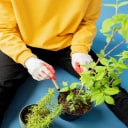ginkgo tree
The Ginkgo Bonsai (also known as Ginkgo biloba) was discovered in eastern China and is unique as the last remaining member of trees common in prehistoric times. In eastern cultures, the Ginkgo tree is considered to be the “Fountain of Youth” plant, which helps promote overall health. Recognizable for its fan-style fossil leaves, Ginkgos are deciduous trees and will lose all of their leaves during the winter. With proper care, Ginkgos can live to be up to 100 years or more.
ginkgo tree Specifications:
– Bonsai Tree Age: 4-6 Years Old
– Height: 12″ – 15″ Tall Potted
– Pot: 8″ Ceramic Bonsai Pot
– Classification: Broadleaf Deciduous
– Level: Beginner/Intermediate
The Ginkgo Bonsai tree enjoys full sun or partial shade. The sun will increase the autumn color. Pot shape may vary depending on availability. Care information included. Ginkgo bonsai tree shape may vary from shown.
Tree Type: Deciduous (Loses all leaves during Winter)
| Pruning Tips: Prune the Ginkgo with sharp gardening shears. Prune branches and old shoots in late spring. New growth is sporadic and random on a Ginkgo. |
|
|
|
|
| Fertilizing: Fertilize twice a month during spring/mid-summer and in early September-October. |
|
|
|
|
 |
Lighting: The Ginkgo Bonsai tree enjoys full sun to partial shade. The low intense sun will improve the autumn yellow color of the leaves. |
|
|
|
| Temperature Requirements: Protect the Ginkgo Bonsai from prolonged or severe freezing, as the roots can expand with water from the frost and burst. |
|
|
|
|
| Watering Requirements: Water the Ginkgo Bonsai daily, keeping the tree and soil moist at all times. Spray foliage regularly. During winter, the soil should be kept fairly dry to avoid frost damage to the roots. |
|
|
|
|
| Repotting: You can repot the Ginkgo Bonsai every year in late winter or early spring. |
|
|
|
|
 |
Indoor / Outdoor: The Ginkgo Bonsai thrives best in outdoor conditions. During the winter, trees can be overwintered to protect them from freezing. This tree will lose all its leaves during winter. Proper care during the winter period will ensure growth in the spring. |








Reviews
Clear filtersThere are no reviews yet.